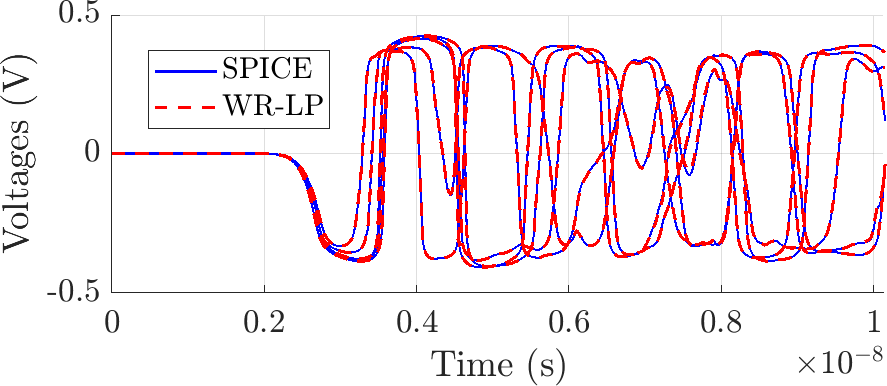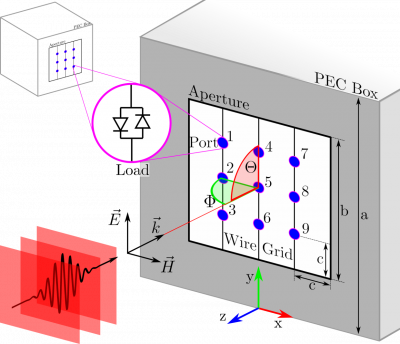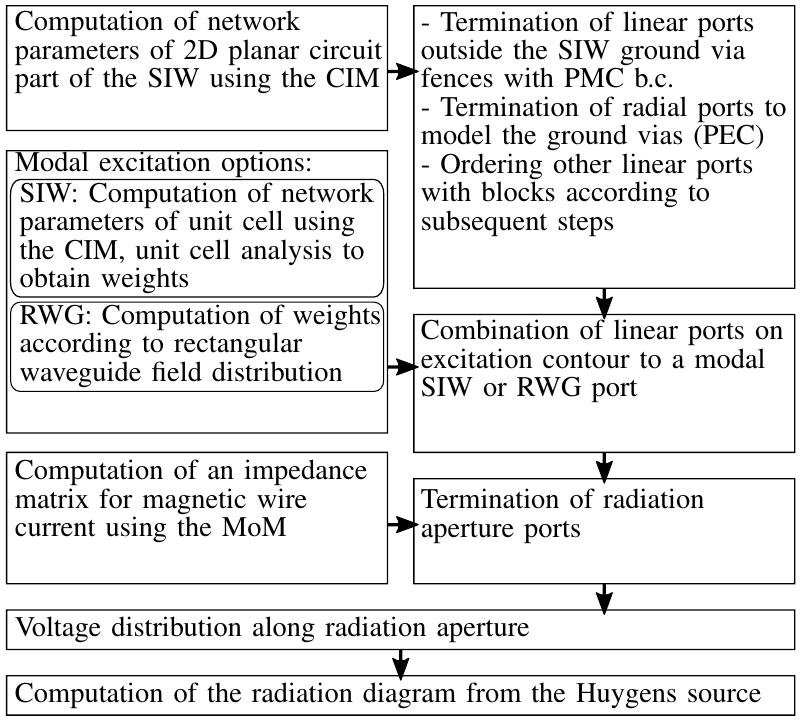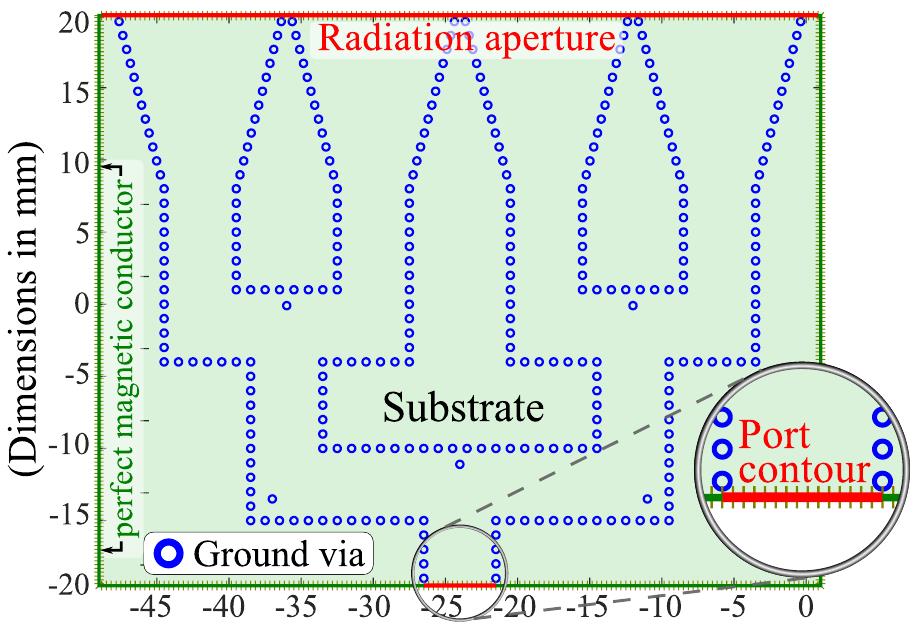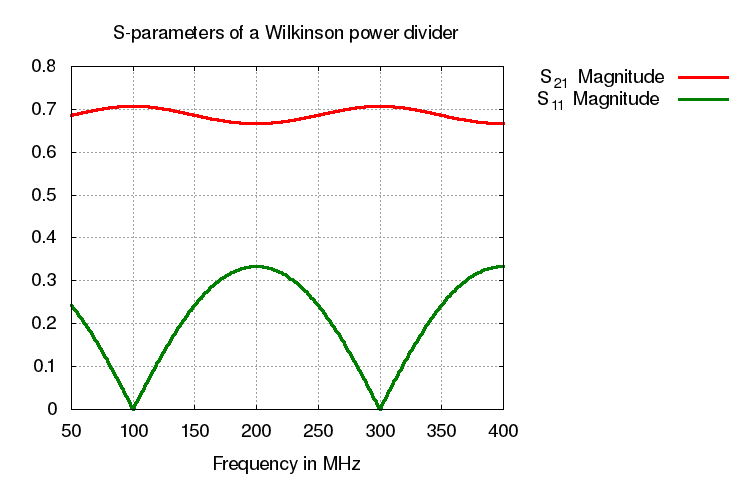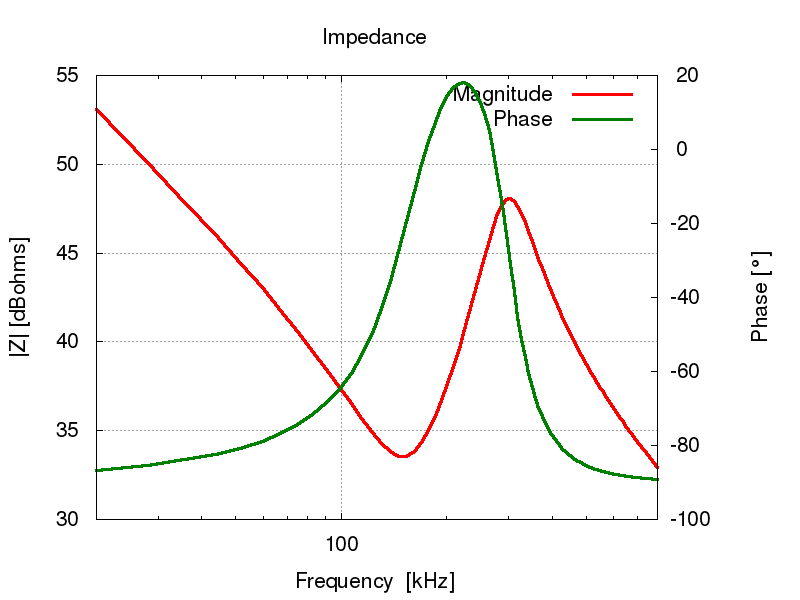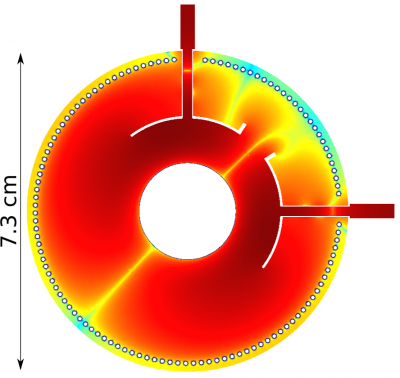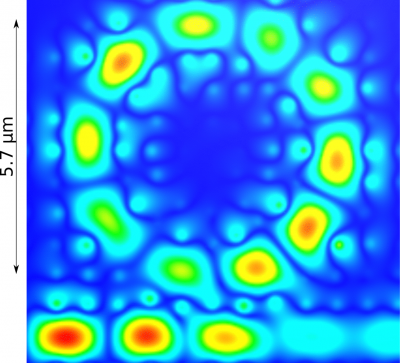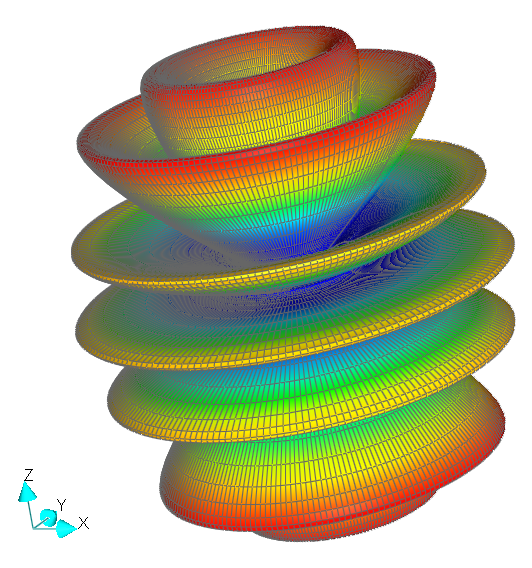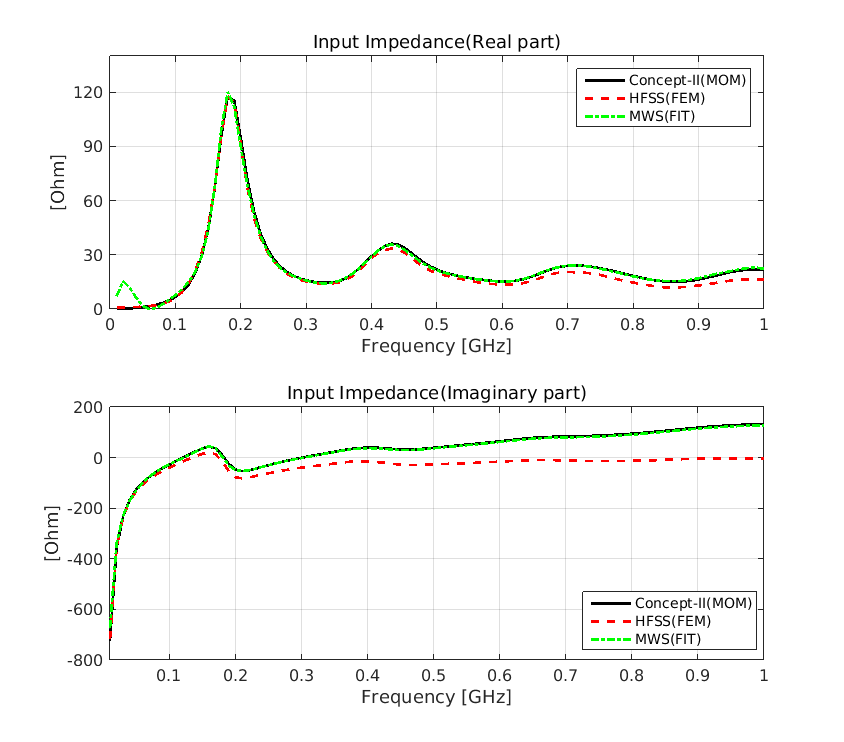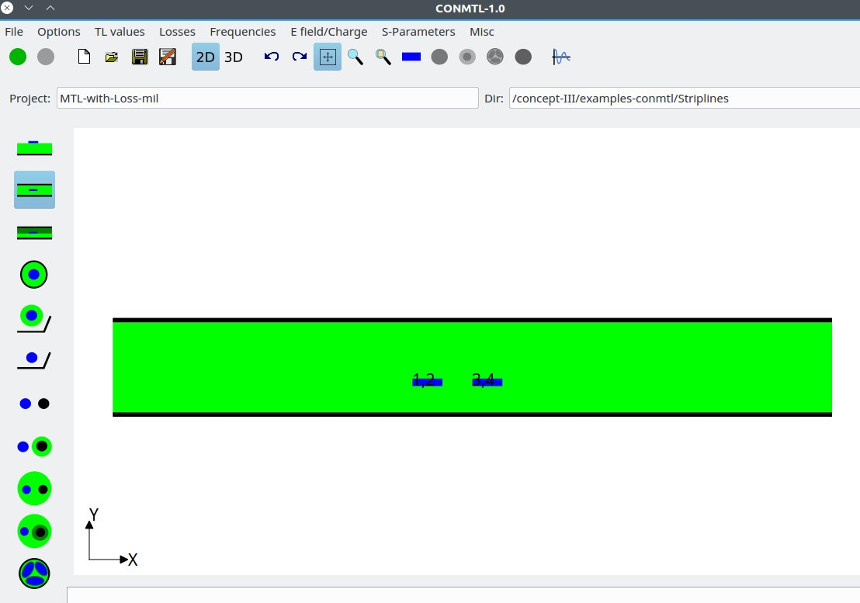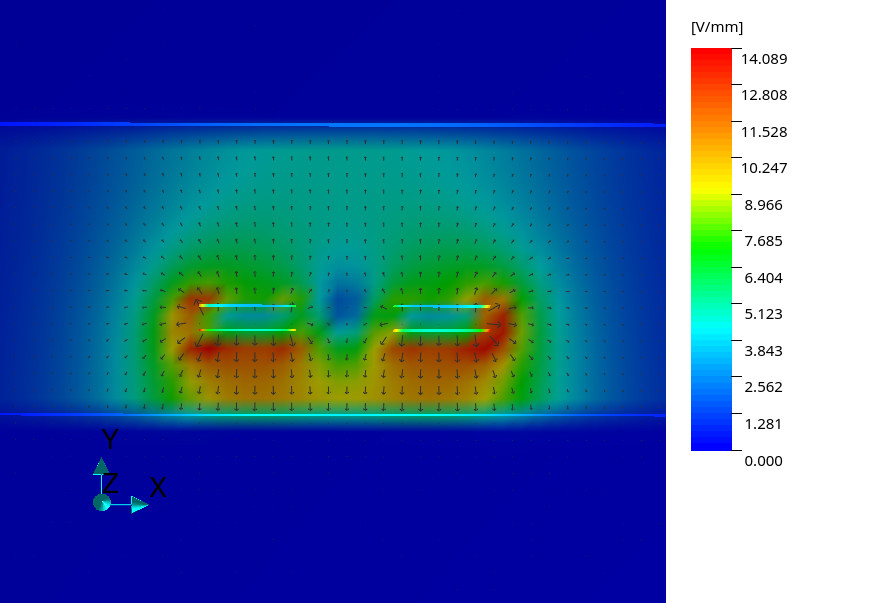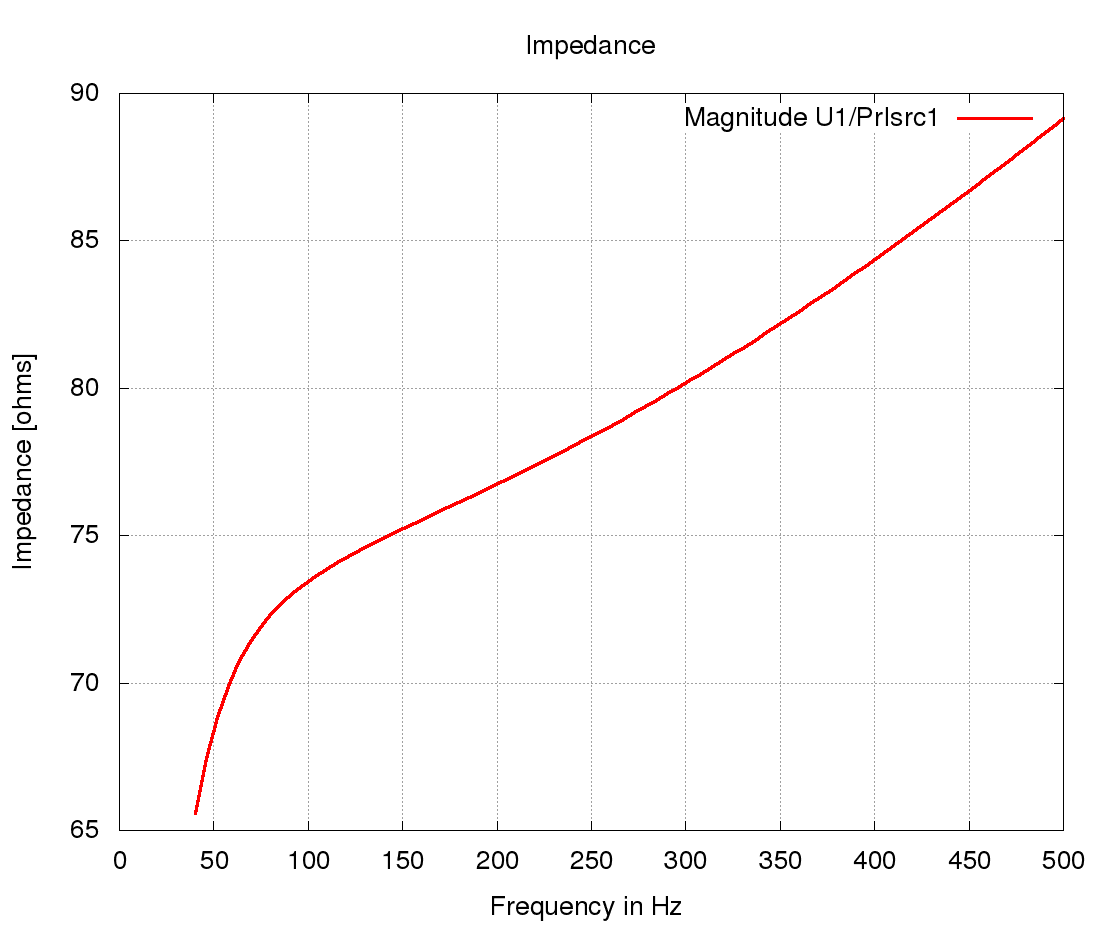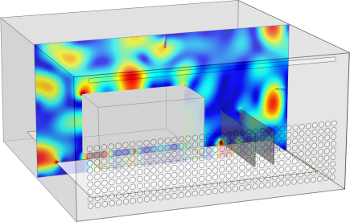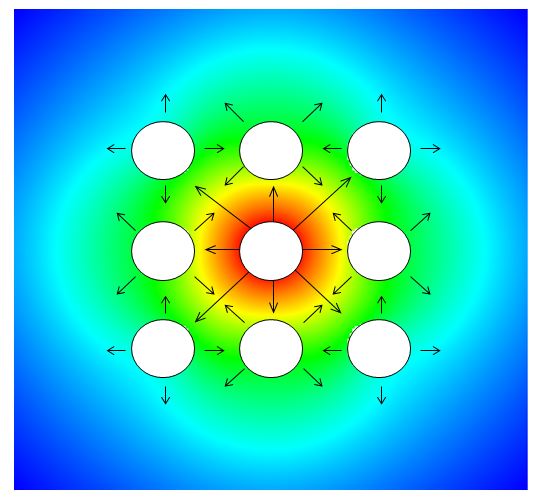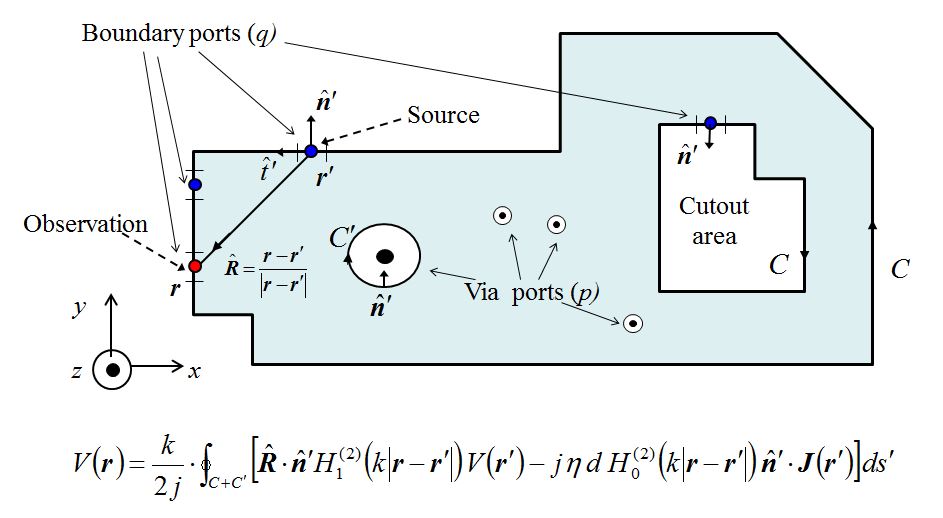Converting IC layout into 3D CAD Models for EM analysis
Ann-Sophie Woldmann, Research Assistant, 15.05.2023-14.11.2023
In the past decade, there has been a rapid advancement in using integrated circuit (IC) techniques for wireless applications, allowing for fully functional implementation in a small volume. Although sophisticated full-wave models of highly complex IC interconnects and their packages up to GHz have been reported in the literature, the IC itself, which consists of a huge number of transistors, has not yet been fully characterized in full-wave form. This is crucial for chip-level electromagnetic compatibility (EMC) evaluation.
The aim of this project is to develop an efficient numerical tool that can process standard IC layout data for full-wave electromagnetic (EM) simulation. The tool will automatically identify all types of transistors of different sizes and replace them flexibly with circuits or sources. It will export a ready-to-use 3D model from standard GDSII IC layouts, along with customized scripts to set up the full-wave simulation environment using commercial software. The full-wave EM simulation will then be conducted, and the results can be collected for examination.
Depiction of creating a full-wave EM simulation from a standard IC layout. The numerical tool (red color block) will interpret the 2D layout file, identify all transistors, create 3D models with ports (field-circuit interfaces), and automate all manual operations in simulation software with scripts, making the modeling and analysis more efficient and flexible.
Fast Simulations of Energy Selective Surfaces via Reduced Order Models
Marco de Stefano, M.Sc., DAAD Scholarship from Department of Electronics and Telecommunications,
Politecnico di Torino (POLITO), Torino, Italy, 01.09.2021 – 10.12.2021
Since the 1970s, when the starting point was a single wire antenna loaded with a diode, the simulation of electrical/electromagnetic structures with nonlinear terminations is major topic of interest in the academia. Examples are active antennas, grid amplifiers, amplifier with shielding structures, on-chip interconnects with NL terminations, multistage amplifiers, and PCB decoupling problems. The general trend over the years shows dynamical systems of increasing size, massively loaded with NL components.
The aim of this project is improving the state-of-the-art in numerical simulation of large electrical/electromagnetic structures massively loaded with NL components/terminations. Examples are meta-surfaces for nonlinear shielding, or power delivery networks in Printed Circuit Boards (PCBs). The interplay between distributed (electrically large) nature and presence of NL terminations make the numerical simulation problem (to be cast in time-domain) extremely challenging. Our main effort will be dedicated to address two major limitations of state-of-the-art mixed circuit/field simulation methods, with specific reference to approaches based on model-order-reduction (macromodeling):
- Improve and streamline generation of compact, passive and reliable macromodels for large-scale components, with hundreds of ports, obtained from tabular frequency responses
- Systematic extraction and inclusion of reduced-order models also for the nonlinear terminations in a dedicated simulation environment, when the number of NL loads becomes very large
Since 2018, the groups of TUHH and POLITO have been working together at the project “Hybrid Simulation of Electromagnetic Field Interaction with Metallic Structures Showing Massive Nonlinear Loading”, supported by DFG. The ongoing collaboration is aimed to advance the state-of-the-art in the simulation of field interactions with nonlinear loaded structure, with a focus on meta-surfaces (metallic grids connected with diodes). The project involves a Ph.D. student from TUHH, M.Sc. T. Wendt, with special care to the interface between the home-made MoM solver provided by TUHH and the macromodeling generation part.
A full report of his scholorship is given in the following document: PDF
Related Publication:
A Waveform Relaxation Solver for Transient Simulation of Large-Scale Nonlinearly Loaded Shielding Structures Journal Article In: IEEE Transactions on Electromagnetic Compatibility, vol. 64, no. 6, pp. 2042 - 2054, 2022. |
Regularized and Compressed Large-Scale Rational Macromodeling: Theory and Application to Energy-Selective Shielding Enclosures Journal Article In: IEEE Transactions on Electromagnetic Compatibility, vol. 64, no. 5, pp. 1365-1379, 2022. |
A Multistage Adaptive Sampling Scheme for Passivity Characterization of Large-Scale Macromodels Journal Article In: IEEE Transactions on Components, Packaging and Manufacturing Technology, vol. 11, no. 3, pp. 471-484, 2021. |
Field Interaction with Nonlinear Structures
Ph.D. Thesis Torben Wendt, 16.08.2017 – 14.10.2022
This project aims to contribute at the intersection of three different research areas:
- physics of electromagnetic field interaction with nonlinearly loaded, electrically large
structures and surfaces, - novel engineering applications for such structures and surfaces, and
- efficient and stable numerical modeling and simulation of such structures and surfaces.
While – at least in principle – any radio transmission system is an example for the application of electromagnetic field interaction with a nonlinearly loaded structure (antenna connected to input stage including e.g. mixer and amplifiers) and as such is well understood and can be designed readily with existing commercial software, it is the massive loading, i.e. the connection of several hundreds of nonlinear loads over an electrically large area, that has been of interest in the recent past and that poses new challenges and opportunities for research. Applications that are foreseen or already looked at for these kind of structures and surfaces include energy-selective shielding waveform-dependent absorption, self-focusing of surface waves, RF limiters, subwavelength imaging, nonlinear radar and switching, and time-domain windowing among others.
The research project is conducted in cooparation with Prof. Grivet-Talocia of the Department of Electronics and Telecommunications Politecnico di Torino (POLITO), Italy. The team of Prof. Grivet-Talocia has both expertise in fields of reduced-order macromodeling and fast circuit simulation, both of which are essential for this project. The EMC Group at POLITO is one of the major contributors in both theory and applications of behavioral macromodeling techniques for electrical and electromagnetic systems. Prof. Grivet-Talocia is co-Author of the first book on Passive Macromodeling [02], together with Dr. Gustavsen. Since 2001, Prof. Grivet-Talocia and his group developed tool IdEM, a collection of state-of-the-art algorithms for macromodel generation.
Box with nonlinearly loaded grid across aperture. All sides of the box are a = 50 cm, the square aperture is b = 25 cm and the port spacing is c = 6.25 cm. The grid is modeled using patches with patch width 2 mm. Nine ports loaded with antiparallel diodes connected to the grid create a field dependent shield. A gaussian modulated sinusoid with plane wave fronts excites the structure. The scattered field is measured at observers inside and outside of the cavity (observers not displayed).
(a): maximum electric field strength at a single observer inside the box depicted in Fig. 1 for different excitation amplitude. (b): shielding effectiveness of the same structure as a function of the incident field amplitude, for different observers inside the box where each line corresponds to a different location, as indicated by the markers in the pictograph in the top right.
Related Publication:
Hybrid Simulation of Multiport Structures for Diode Based Shielding Applications PhD Thesis 2023, ISBN: 978-3-8440-9129-8. |
A Waveform Relaxation Solver for Transient Simulation of Large-Scale Nonlinearly Loaded Shielding Structures Journal Article In: IEEE Transactions on Electromagnetic Compatibility, vol. 64, no. 6, pp. 2042 - 2054, 2022. |
Regularized and Compressed Large-Scale Rational Macromodeling: Theory and Application to Energy-Selective Shielding Enclosures Journal Article In: IEEE Transactions on Electromagnetic Compatibility, vol. 64, no. 5, pp. 1365-1379, 2022. |
Signal Integrity Assessment of External ESD Protection for Gbits/s Data Rates on Ceramic Test Fixture Proceedings Article In: IEEE Workshop on Signal and Power Integrity (SPI), Siegen, Germany, May 22 -25, 2022. 2022. |
Iteration Dependent Waveform Relaxation for Hybrid Field Nonlinear Circuit Problems Journal Article In: IEEE Transactions on Electromagnetic Compatibility, vol. 64, no. 4, pp. 1124-1139, 2022. |
Analysis and Optimization of Nonlinear Diode Grids for Shielding of Enclosures With Apertures," Journal Article In: IEEE Transactions on Electromagnetic Compatibility, vol. 63, no. 6, pp. 1884-1895, 2021. |
Distributed Nonlinear Shielding in Power Delivery Networks on Printed Circuit Boards Proceedings Article In: IEEE Conference on Electrical Performance of Electronic Packaging and Systems (EPEPS), virtual event, Austin, TX, USA, October 17-20, 2021. |
A Multistage Adaptive Sampling Scheme for Passivity Characterization of Large-Scale Macromodels Journal Article In: IEEE Transactions on Components, Packaging and Manufacturing Technology, vol. 11, no. 3, pp. 471-484, 2021. |
A Macromodeling-Based Hybrid Method for the Computation of Transient Electromagnetic Fields Scattered by Nonlinearly Loaded Metal Structures Journal Article In: IEEE Transactions on Electromagnetic Compatibility, vol. 62, no. 4, pp. 1098-1110, 2020. |
Numerical complexity study of solving hybrid multiport field-circuit problems for diode grids Proceedings Article In: International Conference on Electromagnetics in Advanced Applications (ICEAA), Granada, Spain, September 9-13, 2019. |
Direct Prediction of Linear Equalization Coefficients Using Raised Cosine Pulse Shaping in Frequency Domain Proceedings Article In: IEEE Workshop on Signal and Power Integrity (SPI), Brest, France, May 22-25, 2018. |
Fast Analysis and Optimization of Substrate Integrated Waveguide (SIW) Antennas Using the Contour Integral Method (CIM)
Dr. Lei Wang (Alexander von Humboldt Fellowship) 01.02.2018-31.01.2020
Based on previous research and simulations tools developed at the TET-institute, we have developed a fast simulation method to calculate the fields on the contours of a standard SIW horn antenna and its radiated fields. The approach is a combined/hybrid method of the CIM and a method of moments (MoM) as shown in Fig. 1.
Illustration of the principal steps of the proposed method to calculate SIW horn antennas.
After computation of the planar circuit properties with the CIM and termination of ports according to appropriate boundary conditions, a model port is introduced by a post processing. Furthermore, the radiation is modeled by concatenating a matrix that is computed with a MoM code for magnetic wire currents. The result is an input impedance for a modal port that is similar to a rectangular waveguide port, see Fig. 2. This also enables the computation of the contour voltage distribution which in turn can be used to compute radiated field properties in terms of radiation diagrams, see Fig. 2, using Huygens’ principle. The hybrid CIM/MoM approach is more efficient and results in a speed-up of about two to three orders of magnitude compared to finite element simulations.
Example structure, input impedances
A full report of his fellowship is given in the following document: PDF
Extending the Possibilities of the Linear Network Solver CONCIRC
Heinz-D. Brüns, Angela Freiberg, 01.10.18-31.01.19
In practice it is helpful in many cases to be able to display system responses not only as a function of frequency. Therefore the program has been extended such that it is now also possible to compute output quantities as a function of varying element values. In this context it has to be emphasized that all input quantities can be parameterized, i.e. in addition to the standard quantities R, L, C also the distributed inductance per unit length or capacitance per unit length, characteristic impedances or the control quantities of controlled current or voltage sources and so on.
The above figure shows a simple parallel resonant circuit fed by a current generator. It can be observed that the element values of R1, L1, and C1 are to be changed in certain intervals where in the example 10 steps for each element are assumed. As the frequency sampling comprises more
than 90 steps at the same time we already have more than 90000 data sets to be stored. This is accomplished in the h5 data format. The graphical output of arbitrary dependencies is possible in an easy way.
Furthermore the computation of S-parameters has been enabled based on the underlying MNA algorithm. For this purpose a special port element has been introduced. The circuit under investigation is allowed to contain all available elements of the program except for active voltage or current sources. As an example the computed S-parameters of a Wilkinson power divider are shown in the figure below. The divider is dimensioned for an operating frequency of 100 MHz.
Heinz-D. Brüns, Angela Freiberg, 20.09.17-20.12.17
After the release of the linear network solver CONCIRC which can be downloaded from the website of the institute numerous suggestions for extensions and improvements have reached the developers. Based on this the graphical output has been extended by
- Bode plots
- Nyquist plots
Numerous settings are provided for creating the curves to be plotted.
Two examples are demonstrated in the following figures:
Furthermore the following features were introduced:
- Non-ideal transformer including the elements L1,L2, M12
- Extension of the current controlled voltage source for the modeling of magnetically coupled circuits
- Output of all computed quantities in dB
- Input of complex control data for all dependent sources from files
- Complex amplitudes of voltage and current generators from files
- Direct input of complex impedances
Extension of the Contour Integral Method for Stochastic Modeling of Waveguiding Structures
Ph. D. Thesis Jan Birger Preibisch, 01.02.2013 – 30.06.2017
Electromagnetic fields confined in a printed circuit board (PCB) cavity, the field inside a substrate integrated waveguide (SIW), and the normal scattered fields of infinitely extended structures have in common that the wave vector lies in a plane. In this thesis, the Contour Integral Method (CIM) is extended to model practical problems and devices as PCBs and planar microwave devices with inhomogeneous substrates and optical devices in TE and TM polarization. Physics-based approaches are used to incorporate transitions to the planar problem. For the handling of stochastic formulations of physics-based models, Polynomial Chaos Expansion (PCE) was used. Algorithms and methodologies are proposed to apply PCE efficiently and comprehensively. The proposed extensions and methods are validated using state of the art real world application examples.
Related Publications:
Sensitivity Analysis and Empirical Optimization of Cross-Domain Coupling on RFICs using Polynomial Chaos Expansion Proceedings Article In: 2017 IEEE International Symposium on Electromagnetic Compatibility & Signal/Power Integrity (EMCSI) Washington, DC, USA, 2017. |
Efficient Prediction of Equalization Effort and Channel Performance for PCB-Based Data Links Journal Article In: IEEE Transactions on Components, Packaging and Manufacturing Technology, vol. 7, no. 11, 2017. |
Extension of the Contour Integral Method for Stochastic Modeling of Waveguiding Structures PhD Thesis 2017, ISBN: 978-3-8440-5402-6. |
Efficient Design of Continuous Time Linear Equalization for Loss Dominated Digital Links Proceedings Article In: IEEE Workshop on Signal and Power Integrity (SPI), Lake Maggiore (Baveno), Italy, May 7-10, 2017. |
Exploring Efficient Variability-Aware Analysis Method for High-Speed Digital Link Design Using PCE Proceedings Article In: UBM DesignCon Conference, Santa Clara, CA, USA, January 31 – February 2, 2017. |
Variability Analysis of via Crosstalk using Polynomial Chaos Expansion Proceedings Article In: UBM DesignCon Conference, Santa Clara, CA, USA, January 31-February 2, 2017. |
Design Space Exploration for Printed Circuit Board Vias Using Polynomial Chaos Expansion Proceedings Article In: IEEE Signal and Power Integrity Conference (SIPI) 2016, Ottawa, ON, Canada, July 25-29, 2016. |
Impact of Continuous Time Linear Equalizer Variability on Eye Opening of High-Speed Links Proceedings Article In: IEEE Workshop on Signal and Power Integrity (SPI), Turin, Italy, May 8-11, 2016. |
Extension of the Contour Integral Method for the Modeling of TE Scattering in Two-Dimensional Photonic Structures Using the Duality Principle Proceedings Article In: 2016 10th International Congress on Advanced Electromagnetic Materials in Microwaves and Optics (METAMATERIALS) Crete, Greece, 2016. |
Efficient Stochastic Transmission Line Modeling Using Polynomial Chaos Expansion with Multiple Variables Proceedings Article In: 2015 IEEE MTT-S International Conference on Numerical Electromagnetic and Multiphysics Modeling and Optimization (NEMO), Ottawa, Canada, August 11-14, 2015. |
Physics-Based Via and Waveguide Models for Efficient SIW Simulations in Multilayer Substrates Journal Article In: IEEE Transactions on Microwave Theory and Techniques , vol. 63, no. 6, 2015. |
Sensitivity Analysis of Via Impedance using Polynomial Chaos Expansion Proceedings Article In: 2015 IEEE 19th Workshop on Signal and Power Integrity (SPI), Berlin, Germany, May 10-13, 2015. |
An Efficient Analysis of Power/Ground Planes With Inhomogeneous Substrates Using the Contour Integral Method Journal Article In: IEEE Transactions on Electromagnetic Compatibility, vol. 56, no. 4, 2014. |
Extensions to the Contour Integral Method for Efficient Modeling of TM Scattering in Two-Dimensional Photonic Crystals Proceedings Article In: 7th International Congress on Advanced Electromagnetic Materials in Microwaves and Optics (Metamaterials’2013), Bordeaux, France, September 16-13, 2013. |
Validation of Numerical Methods Using a Comparative Analysis of Canonical Electromagnetic Problems
Sangwook Park, M. Sc., (Ajou Universität, Süd Korea) 26.08.2015 – 11.08.2016
Nowadays 3D electromagnetic (EM) simulators based on different numerical techniques such as the finite element method (FEM), the method of moments (MoM), the finite-difference time- domain technique (FDTD), the transmission-line matrix method (TLM), or the finite integration technique (FIT) are available for the analysis of a wide variety of electromagnetic problems. However it is well known that the results provided by the codes depend on many factors such as a suitable discretization of the structure under investigation or a careful positioning of absorbing boundary conditions. In this context each 3D EM simulator has its own requirements concerning the boundary size, the port type, or the shape of mesh elements. All input quantities have to be specified carefully in order to obtain accurate results. In practice it is difficult to satisfy all conditions and, hence, the simulated results could be “inaccurate”. In this case the questions arises how to validate them.
Based on the IEEE standard 1597 “Standard for Validation of Computational Electromagnetic Computer Modeling and Simulation” various examples are investigated in this project. The goal is to find out how the different methods compare to each other when applied to different types of structures. Canonical validation problems such as dipole antenna, a loop antenna, a thick monopole antenna on a finite plate, and a rectangular cavity with apertures are considered using two commercial programs (based on FEM and FIT) and the code CONCEPT-II developed by the Institute of Electrromagnetic Theory (based on MOM). This project investigates the conditions necessary to obtain accurate results for all mentioned cases.
MoM-Based Computation of Multionductor Transmission Line Per-Unit-Length Parameters
Heinz-D. Brüns, Angela Freiberg. 01.07.2015 – 30.06.2016
The main task of the program CONMTL is the computation of the per-unit-length parameter matrices L’, C’, G’and R’ for multi-conductor transmission lines of arbitrary cross section. The program is based on a method of moments (MoM) technique by means of which a 2D integral equation is solved numerically for electrostatic problems. This integral equation is derived from the 2D Poisson’s equation of electrostatics. In a first step equivalent surface charge distributions are computed by discretizing both conductor and dielectric boundaries into appropriate numbers of straight segments. Over each segment a constant charge basis function is defined. Boundary conditions to be fulfilled are the constant potential on metal conductors and constant normal electric flux density on dielectric boundaries. In this way the integral equation can be converted into a linear system of equations. Solving this matrix equation provides an approximation of the overall charge distribution, both on the metal parts and on dielectric boundaries. This known charge distribution is necessary for the subsequent computation of the mentioned transmission line parameters. Comprehensive possibilities for visualizing the equivalent charge distribution on all cross sectional transmission line parts as well as the E field distribution exist for quickly checking the validity of the numerical solution. Given the length of a transmission line the corresponding Y-parameter matrix can easily be computed using well-known expressions from multi-conductor transmission line theory. Finally S-parameters are provided as a function of frequency.
Implementation of a Linear Network Solver
Heinz-D. Brüns, Angela Freiberg. 01.07.2014 – 30.06.2015
The program CONCIRC is a simple network solver including all basic features necessary to support the studies of students attending the lecture „Electrical Engineering Fundamentals II’. They can use the program in order to get more insight into the specific behaviour of excercises. CONCEPT-II users can place lumped loads at ports for example. Y-parameter matrices can be read in various formats. The graphing utility „Gnuplot“ <a href=”http://www.gnuplot.info”>http://www.gnuplot.info</a> is used for displaying voltages, currents or impedances as a function of frequency and needs to be installed additionally. Gnuplot is not part of CONCIRC.
Fast Direct H-Matrix Solvers for Computational Electromagnetics
Ph. D. Thesis Alexander Vogt, 01.02.2014 – 30.06.2015
In this project, fast direct solvers based on hierarchical (H-) matrices are investigated and extended to cope with arbitrary boundary conditions. The goal of the project is a fast electromagnetic solver based on the method of moments (MoM) that is applicable to a wide range of problems.
These solvers are particularly interesting for highly resonant structures such as personal computer systems, as iterative solvers show a poor convergence. Furthermore, these systems comprise various components which leads to a high complexity of the simulation setup. Typical components include lossy dielectric and metallic materials, printed circuit boards, cables, and structural components. These are confined in the narrow space of the cavity and impact on the standing pattern. In this scenario, fast numerical methods based on multi-pole expansion of the far field are not feasible and algebraic methods such as the adaptive cross approximation need to be applied. The resulting H-matrices can be efficiently used to solve the MoM system matrix. The implemented solver is part of the Concept-II framework and shows an excellent performance for all frequencies and simulation scenarios a traditional (full) MoM solver can be applied to.
Electric fields calculated in a populated PC system: a metallic enclosure of dimensions (20x20x10 cm) contains a Mini-ITX mainboard with attached RAM modules and a CPU/heatsink configuration. In the depicted field distribution (8GHz), a monopole antenna is used to represent the RF excitation of the CPU. At these frequencies, 100000 unknowns are required to discretize the surface current distribution. The numerical calculation could be performed in less than an hour on four cores – including the evaluation of the electric fields at more than one million observation points. (Source: TET, TUHH).
Scaling behavior of the direct H-matrix solver at the example of a dielectric sphere: the asymptotic complexity of the matrix setup could be reduced from O(N^2) to O(N^(4/3) logN ). The complexity of the solution stage is reduced from cubic to quadratic complexity. This illustrates the superiority of the H-matrix algorithm for solving large electromagnetic problems. (Source: TET, TUHH).
Related Publications:
Modeling challenging EMC problems Journal Article In: IEEE Electromagnetic Compatibility Magazine, vol. 6, no. 3, pp. 45-54, 2017. |
Analysis of Electromagnetic Interference in Server Casings PhD Thesis 2016, ISBN: 978-3-8440-4660-1. |
On the Treatment of Arbitrary Boundary Conditions Using a Fast Direct H-Matrix Solver in MoM Journal Article In: IEEE Transactions on Antennas and Propagation, vol. 64, no. 8, 2016. |
Auswirkung absorbierender Materialien auf die Verkopplung von Komponenten innerhalb eines PC-Gehäuses Proceedings Article In: Internationale Fachmesse und Kongress für Elektromagnetische Verträglichkeit (EMV Düsseldorf) Düsseldorf, Germany, February 23-25, 2016. |
A Measurement Setup for Quantification of Electromagnetic Interference in Metallic Casings Journal Article In: IEEE Transactions on Electromagnetic Compatibility, vol. 57, no. 6, 2015. |
Modeling of Mutual Coupling between Coaxial Probes in Flat Metallic Casings Using the Contour Integral Method Proceedings Article In: 2015 International Conference on Electromagnetics in Advanced Applications (ICEAA), Turin, Italy, September 07-11, 2015. |
Numerical and Experimental Evaluation of Electromagnetic Coupling between Radiating Antenna Structures inside a Computer Casing Proceedings Article In: 2015 IEEE International Symposium on Electromagnetic Compatibility (EMC) Dresden, Germany, August 16-22, 2015. |
Solving highly resonant structures using a fast direct H-matrix solver in the method of moments Workshop IEEE EMC International Symposium on Electromagnetic Compatibility, Dresden, Germany, August , 2015. |
Modeling using MoM – Solving challenging realworld problems Workshop IEEE EMC International Symposium on Electromagnetic Compatibility, Gothenburg, Sweden, September, 2014. |
Einfluss von absorbierenden Materialien auf die elektromagnetische Strahlung von Leiterplatten Proceedings Article In: Internationale Fachmesse und Kongress für Elektromagnetische Verträglichkeit (EMV Düsseldorf) , Düsseldorf, Germany, March 11-13, 2014. |
Modeling Absorbing Materials in Cavities with Apertures Using the Thin Sheet Approximation Proceedings Article In: Asia-Pacific EMC Symposium (APEMC), Melbourne, Australia, May 20-23, 2013. |
Progress Towards a Combined CIM/MoM Approach for EMI Analysis of Electronic Systems Proceedings Article In: IEEE EMC Europe Symposium, Rome, Italy, September 17-21, 2012. |
Applicability of the Thin Sheet Approximation to the Analysis of EM Emission from Coated PCBs Proceedings Article In: IEEE EMC International Symposium on Electromagnetic Compatibility, Pittsburgh, USA, August 5-10, 2012. |
Extension of the Contour Integral Method for the Electrical Design of Planar Structures in Digital System
Ph. D. Thesis Xiaomin Duan. 01.09.2007 – 31.07.2013
The fast-paced evolution of the semiconductor industry is putting forth great challenges on electronic design automation tools.
This thesis focuses on the efficient and accurate modeling of planar structures and power planes in digital systems by the extension of a fast two-dimensional numerical technique, the contour integral method. The extension includes the derivation of analytical expressions for rapid analysis of cylindrical vias as well as the combination with other efficient approaches for handling of complex multilayer systems. The validation and evaluation of the method and its extension are thoroughly addressed by a variety of application examples.
TUHH Universitätsbibliothek. TUBDok Link: http://doku.b.tu-harburg.de/volltexte/2012/1157
Related Publications:
Bayesian Optimization of First-Order Continuous-Time Linear Equalization in High-Speed Links Including Crosstalk Proceedings Article In: IEEE Workshop on Signal and Power Integrity (SPI), Aveiro, Portugal, May 07-10, 2023. |
ANN Hyperparameter Optimization by Genetic Algorithms for Via Interconnect Classification Proceedings Article In: IEEE Workshop on Signal and Power Integrity (SPI), virtual event, Siegen, Germany, May 10-12, 2021. |
SI/PI-Database of PCB-Based Interconnects for Machine Learning Applications Journal Article In: IEEE Access, vol. 9, pp. 34423-34432, 2021. |
Efficient Prediction of Equalization Effort and Channel Performance for PCB-Based Data Links Journal Article In: IEEE Transactions on Components, Packaging and Manufacturing Technology, vol. 7, no. 11, 2017. |
High Frequency Characterization of Silicon Substrate and through Silicon Vias Proceedings Article In: Electronic Components and Technology Conference (ECTC), Las Vegas, US, May 31 – June 3, 2016. |
A Rigorous Approach for the Rigorous Approach Using Multipole Expansions Journal Article In: IEEE Transactions on Components, Packaging and Manufacturing Technology, vol. 6, no. 1, 2016. |
Efficient Computation of Localized Fields for Through Silicon Via Modeling Up to 500 GHz Journal Article In: IEEE Transactions on Components, Packaging and Manufacturing Technology, vol. 5, no. 12, 2015. |
Comparison of Passivation Materials for High frequency 3D Packaging Application up to 110 GHz Proceedings Article In: 2015 European Microelectronics Packaging Conference (EMPC), Friedrichshafen, Germany, September 14-16, 2015. |
2015 IEEE 19th Workshop on Signal and Power Integrity (SPI), Berlin, Germany, May 10-13, 2015. |
An Efficient Analysis of Power/Ground Planes With Inhomogeneous Substrates Using the Contour Integral Method Journal Article In: IEEE Transactions on Electromagnetic Compatibility, vol. 56, no. 4, 2014. |
Energy-aware analysis of electrically long high speed I/O links Journal Article In: Computer Science – Research and Development, vol. 29, no. 2, 2014. |
Applying a physics-based via model for the simulation of Through Silicon Vias Proceedings Article In: IEEE Conference on Electrical Performance of Electronic Packaging and Systems (EPEPS), San Jose, USA, October 27-30, 2013. |
Extensions to the Contour Integral Method for Efficient Modeling of TM Scattering in Two-Dimensional Photonic Crystals Proceedings Article In: 7th International Congress on Advanced Electromagnetic Materials in Microwaves and Optics (Metamaterials’2013), Bordeaux, France, September 16-13, 2013. |
Efficient DC Analysis of Power Planes Using Contour Integral Method With Circular Elements Journal Article In: IEEE Transactions on Components, Packaging and Manufacturing Technology, vol. 3, no. 8, pp. 1409 - 1419, 2013. |
IEEE Workshop on Signal and Power Integrity (SPI), Paris, France, May-12-15, 2013. |
Signal and Power Integrity (SPI) Co-Analysis for High-Speed Communication Channels Proceedings Article In: UBM DesignCon Conference, Santa Clara, USA, January 28-31, 2013. |
Accuracy of Physics-Based Via Models for Simulation of Dense Via Arrays Journal Article In: IEEE Transactions on Electromagnetic Compatibility, vol. 54, no. 5, 2012. |
Progress Towards a Combined CIM/MoM Approach for EMI Analysis of Electronic Systems Proceedings Article In: IEEE EMC Europe Symposium, Rome, Italy, September 17-21, 2012. |
Energy-Aware Analysis of Electrically Long High Speed I/O Links Journal Article In: Computer Science – Research and Development, August 2012 and International Conference on Energy-Aware High Performance Computing (EnA-HPC), Hamburg, Germany, September 12, 2012. |
Circular Ports in Parallel-Plate Waveguide Analysis with Isotropic Excitations Journal Article In: IEEE Transactions on Electromagnetic Compatibility, vol. 54, no. 3, 2012. |
Extension of the Contour Integral Method for the Electrical Design of Planar Structures in Digital Systems PhD Thesis 2012, ISBN: 978-3-8440-1059-6. |
Extension of the Contour Integral Method to Anisotropic Modes on Circular Ports Journal Article In: IEEE Transactions on Components, Packaging and Manufacturing Technology, vol. 2, no. 2, 2012. |
Impact of Multiple Scattering on Passivity of Equivalent-Circuit Via Models Proceedings Article In: IEEE Electrical Design of Advanced Package & Systems Symposium (EDAPS), Hangzhou, China, December 12-14, 2011. |
Recent Developments of Via and Return Current Path Modeling (Invited) Proceedings Article In: International Conference on Electromagnetics in Advanced Applications (ICEAA), Torino, Italy, September 12-16, 2011. |
A Hybrid CIM/MoM Approach for Power Plane Analysis Including Radiation Loss Proceedings Article In: Asia-Pacific EMC Symposium (APEMC), Jeju Island, Korea, May-16-19, 2011. |
Non-Uniform Currents on Vias and Their Effects in a Parallel-Plate Environment Proceedings Article In: IEEE Electrical Design of Advanced Package & Systems Symposium (EDAPS), Singapore, December 7-9, 2010. |
A Combined Method for Fast Analysis of Signal Propagation, Ground Noise, and Radiated Emission of Multilayer Printed Circuit Boards Journal Article In: IEEE Transactions on Electromagnetic Compatibility , vol. 52, no. 2, 2010. |
Fast and Concurrent Simulations for SI, PI, and EMI Analysis of Multilayer Printed Circuit Boards (invited) Proceedings Article In: Asia-Pacific Symposium on EMC (APEMC), Beijing, China, April 12-16, 2010. |
Special Session on Power Integrity Techniques: Contour Integral Method for Rapid Computation of Power/Ground Plane Impedance Proceedings Article In: IEC DesignCon Conference, Santa Clara, USA, February 1-4, 2010. |
Comprehensive Multilayer Substrate Models for Co-Simulation of Power and Signal Integrity Proceedings Article In: IMAPS 42th International Symposium on Microelectronics and Packaging, San Jose, California, USA, November 3-5, 2009. |
EM Emission of Differential Signals Across Connected Printed Circuit Boards in the GHz Range Proceedings Article In: IEEE International Symposium on Electromagnetic Compatibility, Austin, USA, August 17-21, 2009. |
Differential to Common Mode Conversion Due to Asymmetric Ground Via Configurations Proceedings Article In: IEEE Workshop on Signal Propagation on Interconnects (SPI), Strasbourg, France, May 12-15, 2009. |
A Contribution to the PEEC-Method and its Hybridisation with the Method of Moments
Ph. D. Thesis Volker Vahrenholt. Completed in 2009
In order to inspect the elctromagnetic compatibility (EMC) behavior of complex electrical devices, numerical methods have been developed for current-simulation purposes. In this paper, the partial element equivalent circuit approach (PEEC) is treated and advanced for examining the current distribution on printed circuit boards (PCBs). Moreover, a hybridization of PEEC and the method of moments (MoM) is performed in order to combine the advantages of PEEC and MoM. The gain of the hybrid method is that the computation time is reduced significantly compared to a full-wave MoM-approach.
Related Publications:
Fast EMC Analysis of Systems Consisting of PCBs and Metallic Antenna Structures by a Hybridization of PEEC and MoM Journal Article In: IEEE Transactions on Electromagnetic Compatibility, vol. 52, no. 4, 2010. |
Ein Beitrag zur PEEC-Methode und deren Hybridiesierung mit der Momentenmethode PhD Thesis 2009, ISBN: 978-3-8322-8181-6. |
Fast Analysis of Electromagnetic Field Coupling into PCBs based on the PEEC Method Proceedings Article In: IEEE Symposium EMC Europe, Hamburg, Germany, September 8-12, 2008. |
Verkopplung einer schnellen PEEC-Methode mit der Momentenmethode bei gedruckten Schaltungen mittels der elektrischen Feldstärke Proceedings Article In: Internationale Fachmesse und Kongress für Elektromagnetische Verträglichkeit (EMV Düsseldorf), Düsseldorf, Germany, February 18-21, 2008. |
Razor Blade Functions in the PEEC Method Proceedings Article In: IEEE International Symposium on Electromagnetic Compatibility, Honolulu, USA, July 09-13 July 2007. |
Razor Blade Functions in the PEEC method Proceedings Article In: IEEE International Symposium on Electromagnetic Compatibility, Honolulu, Hawaii, USA, July 8-13, 2007. |
Reduction of Unknowns in PEEC Structures by Exploiting Connectivity of PEEC Cells Journal Article In: IEEE Transactions on Electromagnetic Compatibility, vol. 29, no. 2, 2007. |
Methods for Fast Solution of Large Systems of Equations in the Method of Moments
Ph. D. Thesis Miguel Astner. Completed 31.08.2009
The investigation of complex electrical systems with respect to electromagnetic compatibility (EMC) via the method of moments (MoM) usually leads to a large system of equations with dense matrices. Due to numerical complexity standard solution mehtods are not feasible anymore. In this work methods with much lower numerical complexity than in the classical MoM approach are introduced. Also the parallelization of one of these methods on multi-computer systems is addressed.
Related Publications:
Ausnutzung magnetischer Symmetrie bei der numerischen Analyse von Feldproblemen mit der schnellen Multipolmethode Proceedings Article In: Internationale Fachmesse und Kongress für Elektromagnetische Verträglichkeit (EMV Düsseldorf) , Düsseldorf, Germany, March 9-11, 2010. |
Verfahren zur schnellen Lösung von großen Gleichungssystemen in der Momentenmethode Journal Article In: 2009, ISBN: 978-3-8322-8568-5. |
MoM-Based Analysis of the Immunity of Marine Equipment in a Control Cabinet of Cruise and Container Vessels against 2.4-GHz WLAN Application Proceedings Article In: IEEE EMC Europe Hamburg, Germany, 2008. |
Simple Load-Balancing in Binary-Tree Based Parallel Multilevel Low-Rank Compression Techniques Proceedings Article In: IEEE International Symposium on Electromagnetic Compatibility (EMC), Detroit, USA, August 17-22, 2008. |
Frequenzabhängige Diskretisierung für Strukturelemente in CONCEPT II Technical Report Abschlussbericht zu dem BWB-F&T-Projekt E/E590/1F037 „Lösung großer Systemmatrizen mit der Momentenmethoden“ im Rahmen des Vorhabens „Berechnung Komplexer Übertragungssysteme 2008. |
Ein Verfahren zur schnellen MoM-Berechnung mittels Interpolation der Greenschen Funktion und FFT Proceedings Article In: Internationale Fachmesse und Kongress für Elektromagnetische Verträglichkeit (EMV Düsseldorf) , Düsseldorf, Germany, February 18-21, 2008. |
Application of a Hierarchical SVD/ACA Compression Technique to Near-Field Calculations of Monopole Antennas Proceedings Article In: IEEE International Symposium on Electromagnetic Compatibility Honolulu, Hawaii, USA, July 8-13, 2007. |



